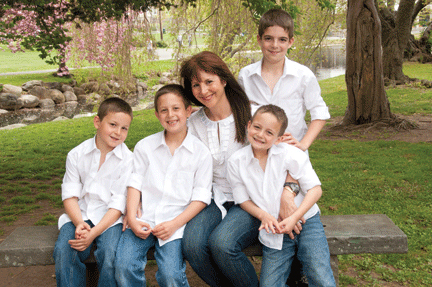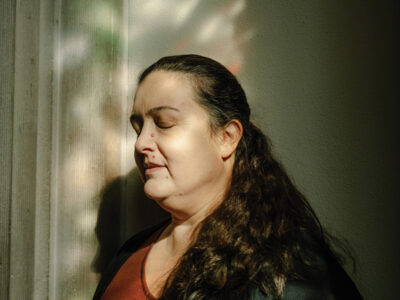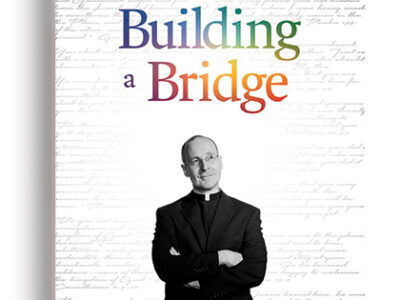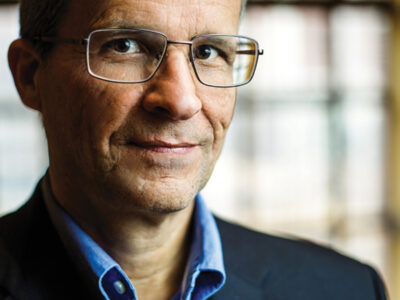
Class of ’91 | If you want something done right, do it yourself. Lucy Eisenstein Waldman Nu’91, a nurse midwife, took that saying to heart by becoming one of a handful of female mohels (someone who performs Jewish ritual circumcisions) in the United States.
When she was eight months pregnant with her fourth son, she mentioned offhandedly to her new rabbi in Millburn, New Jersey, that she wished she herself could perform her son’s circumcision at his bris eight days after his birth. “That way,” she recalls saying, “I could be sure he’d be all right.”
Waldman, after all, was a practicing midwife who regularly performed male circumcisions. Even as a nursing undergraduate at Penn, she found herself leaning toward direct patient care, and she went on to earn her master’s in nurse midwifery at Columbia. (She has been on the staff of St. Luke’s-Roosevelt Hospital in Manhattan since 1995.)
But when standing over the mohel who performed her first son’s bris, she was unpleasantly surprised by the amount of bleeding. When her twin sons had their brises two years later, the (different) mohel also proved unsatisfactory. Enough, Waldman thought, was enough.
Waldman’s rabbi recommended a mohel-certification program for health-care professionals already competent in circumcision. Becoming a mohel requires an intensive program of religious study, even for medical professionals. Waldman attended such a course through the Hebrew Union College-Jewish Institute of Religion Brit Mila program in Los Angeles, passing an exam that enabled her to become certified as a mohel.
Waldman now performs brit mila (Hebrew for the bris ceremony) between three and eight times a month, and describes it as having become her “passion.” Her practice is called Birth to Bris (birthtobris.com), and she often works with interfaith and same-sex couples, making a particular effort to be inclusive on all levels.
“It is important that both parents are in agreement about wanting brit mila, and also that both parents and their families and friends feel welcomed and understand what, exactly, we are celebrating,” Waldman says. “For goodness sake, we are celebrating a new life, along with 6,000 years of tradition!”
Waldman also brings her own experience as a mother of four boys to bear.
“When I do brit mila, I bring my own experiences with brit mila and try to do the complete opposite,” Waldman laughs, recalling her dissatisfaction with her own children’s experiences. “Instead of rushing out of the house, I stay to help the parents change baby’s first diaper—that’s scary stuff! Instead of insisting on my own ceremonial details, I ask the family what they want to bring to their baby’s ceremony—is it a prayer, reading, or special kiddush cup?” Waldman also makes sure to do follow-up visits with the baby (and his often overtired parents), with what she calls a “woman’s touch.”
“I’ve gotten wonderful responses, even though I’m in a traditionally male role,” Waldman says.
Women cannot be certified as mohels in the Orthodox movement, but they can in Reform, Reconstructionist, and Conservative circles. There is an ongoing debate among the Orthodox as to whether women can perform the sacred rite, though the reluctance to accept them in that capacity is based more on tradition than on halacha (Jewish law). While many people are still more accustomed to the idea of male mohels, female mohels, or mohelets, are gaining adherents among new parents.
Though there are no precise numbers available, there are probably fewer than 50 female mohels in the US. Reform Rabbi Julie Pelc Adler, who runs the HUC program, says that her program has never not certified women as mohels. Conservative Rabbi Leonard Scharzer, a physician who serves as associate director for bioethics at the Jewish Theological Seminary, estimates that a third of the trainees in JTS’s certification program for mohels in recent years have been women.
“It’s very important these days surrounding the ritual of brit mila that parents feel empowered in the decision-making,” Scharzer says. “Some parents may feel more comfortable having a woman [as a mohel], and that option should be open to them.”
And Waldman loves being a mohel.
“First, you will never find as much love and support as there is in a room filled with family and friends sharing the joy and celebration of a new life,” she says. “Next, I love hearing, ‘What? It’s finished? But the baby didn’t cry!’ And I love the relief that floods the room, when I show this newly circumcised boy to his mother, father, or grandparents for inspection, just after the deed. But what I like most is when a new mom will tell me that she was indeed able to appreciate the ceremony and day in a spiritual way—because she felt certain her baby would be well taken care of.”
—Jordana Horn Gordon C’95 L’99




